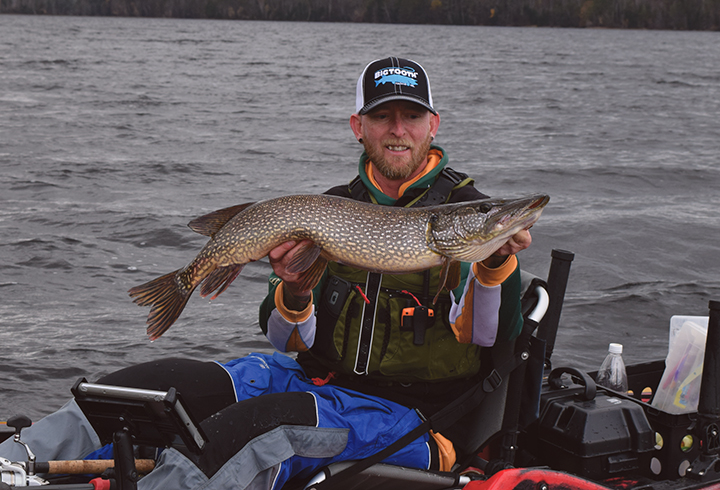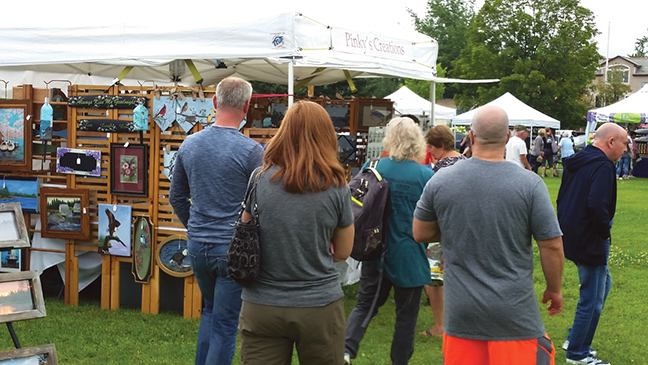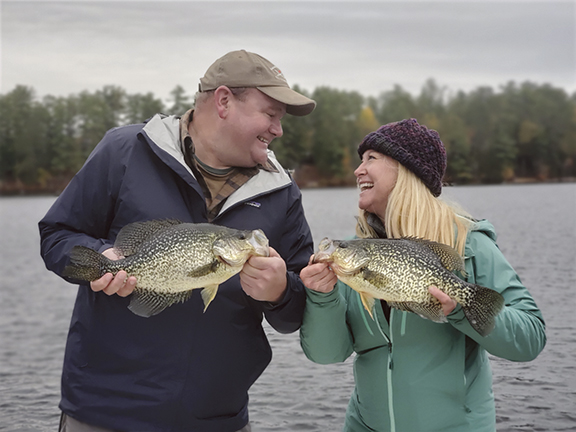New England Nets -Handcrafted Excellence For The Angler

PHOTO: Joey and Scott Rolfe, owners of New England Nets in Belmont, NH. Their fishing nets are 100 percent USA made.
by Rob Levey
Weirs Times Correspondent
Great opportunities sometimes ‘land’ in one’s lap, a metaphor that not only applies to New England Nets, a Belmont-based business that sells handmade wooden landing fish nets, but its very formation.
“In the spring this year, I stumbled upon an opportunity to purchase a small, established net craft business from Alan and Vicki Stevens of Starks, Maine,” explained New England Nets Co-Owner Scott Rolfe.
The business was called Stevens Nets, which had been making and selling wooden landing fish nets for nearly 25 years.
“After purchasing one of Alan’s nets and discovering he was retiring from net making, I was interested in continuing his work,” said Rolfe, a full-time Forester who works on public lands in NH. “With a long time passion of both woodworking and fly fishing, I thought it would make the perfect meld for a small side business.”

Noting the purchase was completed in August, Rolfe selected New England Nets as the business’s new name because New England is “a region known for some of the finest hardwoods in the world.”
“I moved the net manufacturing from Maine to New Hampshire, so I thought it was a fitting name with a nice ring,” said Rolfe, who is joined by wife Joey, a Registered Nurse.
“I make the wooden frames and finishes in the woodshop and Joey weaves the bags onto the nets, packages and ships them,” he added.
In describing landing nets, he said they are used to land a fish that is generally attached to a line on the end of a fishing pole.
“Most fishermen carry a landing net on their person or boat to safely bring a fish to hand,” he explained. “It is often necessary for the fisherman to release the fish due to catch and release regulations, size limits or the fisherman’s preference of catching and releasing all fish.”
A landing net, he said, helps fishermen and women safely do this without hurting the fish.
“Especially one like ours with the fish-friendly rubber bag,” he added. “The rubber bag helps the fish maintain its protective slime on their bodies after release.”

In regards to their overall construction, Rolfe’s process is eco-friendly.
“There are many wood landing nets out on the market but few can claim they are 100% produced from local wood,” he said.
As a Forester, Rolfe searches for raw wood (logs) from local, sustainable forestry operations, while looking for unique grain or characteristics.
“This wood comes from either forestry operations or urban waste wood, which are street trees that are cut down,” he explained. “The wood I source travels a minimum distance, which gives it a very small carbon footprint by the time it makes it to the finished product.”
For Rolfe, New England is the ideal region in which to operate a business like New England Nets.
“New England grows some of the most beautiful hardwoods like maple, cherry, birch and ash,” he said. “There is no need to import exotic species that are shipped from overseas, or may have come from rainforest destruction or timber theft.”
“When you compare the resources needed to produce a net from exotic woods, carbon fiber or aluminum, a landing net constructed from local wood and transported minimally wins the eco-friendly competition every time,” he added.
Aside from the use of locally-sourced wood, Rolfe said another distinguishing characteristic about his products are that they feature solid hoops.

“Most other net manufacturers’ hoops are made by laminating thin strips together, but not ours,” he said. “A solid hoop eliminates the potential for those thin strips to delaminate over time.”
His solid hoops, he explained, are made from white ash, which he said has been used for centuries by both Native Americans and Europeans because it is known for its strength. The ash is bent around forms to produce the hoops while the handle wood, made from a variety of different hardwoods, is also shaped and formed.
“The shapes of these handles are somewhat unique,” he said. “As Alan Stevens told me, ‘They just feel good in your hand,’ and I agree.”
The handle and hoop is then glued up, shaped, sanded and finished. Previous to all this work, Rolfe selects his logs of choice in the woods and then has them sawn into rough sawn lumber. After air drying, he cuts and processes the wood into the needed dimensional stock.
“There are over 30 steps to be completed for a finished landing net ready to ship,” he said.
Currently, New England Nets has four different net designs available with a couple more on the way. There are two basic categories: stream/river nets or boat nets.
“I will most likely keep it between six and eight designs at any one time,” noted Rolfe.
These designs include their smallest tear drop stream net with a 24” overall length, a kayak/canoe net at 34”, a small boat net at 42”, and the largest boat net at 57”.
“There is a net design for every type of fishermen or fisherwomen,” he said.
As for the kinds of fish that may be ‘landed’ by these wooden nets, Rolfe said they will net any species — from a big bass to a lake or brook trout.
“Our logo is a fish jumping out of the water,” he said. “It doesn’t matter what type of fish, and how it was caught or with what, our nets will still bring them to hand just fine.”
As for the future of New England Nets, Rolfe expressed appreciation at bringing together two passions.
“I have been fishing since I was old enough for my dad to take me and woodworking since I was in high school where I had an amazing shop teacher who inspired me,” he said.
From the fishing perspective, Rolfe said he understands the form and function of a landing net and what is required in a design to meet those functions.
“I also understand the aesthetics so it looks like a piece of furniture you would like to keep in your living room,” he said. “It gives me great satisfaction to meld all these skills together to produce a fine crafted wood landing net.”
Rolfe also cited a deeper aspect to the mission behind New England Nets.
“I love being able to take tree, a raw resource nature has provided to us, and actually work and shape it into a usable product,” he said. “Part of my mission is to highlight the utilization of a local renewable resource sustainably while producing a product made right here in the US from raw materials sourced under much more strict environmental guidelines than other countries.”
To learn more about New England Nets, visit facebook.com/newenglandnets.



